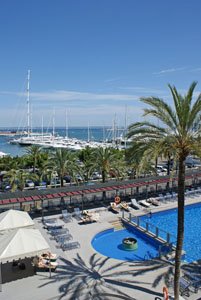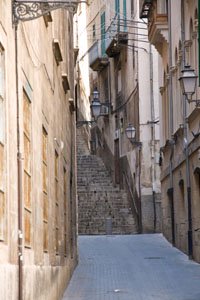Palma de Mallorca, a truly Mediterranean port of call
 Although small in area, Mallorca’s diversity of landscapes, climates and impressions allows it to cater to a great many different tastes, something that has helped to preserve its age-old appeal as a cherished beacon in the seas. Indeed, the fact that Palma’s international airport is the third largest in Spain is an indication of just how prosperous the island has grown on the tourist trade.
Although small in area, Mallorca’s diversity of landscapes, climates and impressions allows it to cater to a great many different tastes, something that has helped to preserve its age-old appeal as a cherished beacon in the seas. Indeed, the fact that Palma’s international airport is the third largest in Spain is an indication of just how prosperous the island has grown on the tourist trade.
But Mallorca’s popularity as a place to soak up the sun, splash around in azure seas and just get away from it all is not a new phenomenon. Evidence suggests that Phoenicians, Greeks and Romans alike used this jewel of the Mediterranean as a place of retreat and repose, making it one of the oldest known tourist destinations in the world. What drew them to this fair isle becomes evident once you lay eyes on its sandy beaches, sheer cliffs, rocky alcoves and deep blue seas.
The largest of the four islands that make up the Balearics, Mallorca’s attractions have not always appealed to peaceful visitors alone. For centuries, it was plagued by pirates, mostly the Corsairs from the Barbary coasts of North Africa, who raided, raped and pillaged, and even carried off citizens to the slave markets of Algiers and Tunis. This menace and the tugs of war between Spain, Britain, France and other powers explain the presence of the many coastal forts and watch towers now used for rather more recreational purposes.
History and sophistication
To many, Mallorca conjures up images of mass tourism and the extensive resorts, bars, clubs and tourist restaurants of El Arenal and Magaluf. While these and other resorts on the sandy south coast do indeed cater especially to large groups of families and youngsters on package tours, Mallorca offers a surprising number of other ways to enjoy its charms. Palma, for one, is a bustling and remarkably sophisticated city of just over 300,000 inhabitants, with sufficient urban atmosphere, history and culture to act as an antidote to the mindless pursuits of the nearby resort towns. This explains why it is a favourite of discerning bons vivants and yachtsmen like Spain’s King Juan Carlos.
As the capital of the Balearic Islands, Palma de Mallorca is also its economic and cultural centre. Set within a wide bay on the south coast, it is a commercial port and an important holiday resort in its own right, yet despite having become a modern, vibrant city, Palma has managed to retain the charm of its old town and an ancient culture that links it with other parts of the Mediterranean. The winding streets of the Gothic quarter, which fan out from the towering Cathedral, are one of the great pleasures of the city. The only proper way to see this area is on foot, yet you will come across a great many peaceful plazas or parks to rest in.
Some of the best sights are to be found near the port, including the Royal Palace, the Stock Exchange and the Castle of Bellver, which has dominated the skyline since the 14th century. The only castle in Spain that is totally circular in design, it was initially built as a royal residence but was later used as a prison and still has graffiti on the walls carved by French prisoners of war. Today the castle houses the principal museum and is often used for concerts. Another experience hidden away in the tiny streets east of the Cathedral are the Arab Baths, dating from the 10th century and set in lush gardens. For typical big-city vibrancy, there are the stylish cafés on the Borne and the Rambla for liveliness and action, opera at the marvellous Teatro Principal, cultural events held at the Moorish Palacio de la Almudaina and the Gothic Lonja, and lively charm in the narrow streets of the Puig de Sant Pere suburb.
 The bay of Palma, a broad crescent of white sand, forms the backdrop for what has become a rather sophisticated playground. Known for its refined upper-middle class atmosphere, quality shops, luxurious yacht clubs and excellent restaurants, Palma is a favoured port of call for well-heeled Madrileños, originally drawn by the fact that it is also the summer retreat of the Spanish royal family. It all started when a group of enterprising businessmen from the island made a present to King Juan Carlos of an Arab palace that lies beside Palma’s Cathedral. Ever since then, Palma has enjoyed the added caché of this royal connection. A great lover of the sea, King Juan Carlos is often seen setting off from the Palma Yacht Club to sail around the island in his yacht Fortuna.
The bay of Palma, a broad crescent of white sand, forms the backdrop for what has become a rather sophisticated playground. Known for its refined upper-middle class atmosphere, quality shops, luxurious yacht clubs and excellent restaurants, Palma is a favoured port of call for well-heeled Madrileños, originally drawn by the fact that it is also the summer retreat of the Spanish royal family. It all started when a group of enterprising businessmen from the island made a present to King Juan Carlos of an Arab palace that lies beside Palma’s Cathedral. Ever since then, Palma has enjoyed the added caché of this royal connection. A great lover of the sea, King Juan Carlos is often seen setting off from the Palma Yacht Club to sail around the island in his yacht Fortuna.
A Mediterranean getaway
A relatively short drive will take you to the north coast, yet the contrast with the beaches and hotels of the south could hardly be greater. Here, among the captivating beauty of a rocky shoreline with isolated coves and little beaches that can only be reached by sea are the luxury resorts and yacht harbours of the rich and famous. The mass tourism of El Arenal and Magaluf contrasts equally with the inland regions, where artists’ villages such as Deià and the wild, green mountains exude an air of time-honoured peace and tranquillity.
Home to such classical society as Frederic Chopin, Georges Sand and Archduke Ludwig of Habsburg, Lorraine and Bourbon, this region is nowadays the place to which contemporary celebrities such as Claudia Schiffer, Elton John and Catherine Zeta-Jones retreat in search of the recuperative charms of classic Mediterranea.










